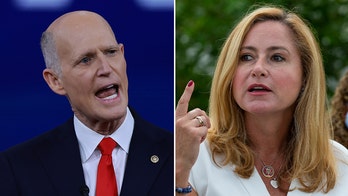Greta: Why isn't Pres. Obama attending Scalia's funeral?
Greta's 'Off the Record' comment to 'On the Record' viewers: Why isn't Obama attending Justice Scalia's funeral on Saturday. The American public deserves an explanation. Let's hope the reason isn't politics.
Senate Majority Leader Mitch McConnell, R-Ky., is bent on refusing to consider any nominee President Obama may submit to succeed late Supreme Court Justice Antonin Scalia. And if he doesn’t give ground, Obama may have only one option for an end-run: a recess appointment.
But Republicans can rest easy: GOP leaders have an ace up their sleeve.
The truth is, it doesn’t take much to prevent a recess appointment, as long as congressional leaders are watching the calendar. Closely.
If you’re trying to block the president from making one to the Supreme Court, all the Senate has to do is commence a session every three days. Because the Senate is only truly in recess after that three-day period.
The Constitution actually requires the House and Senate to meet every three days unless there’s an agreement between the two bodies to skip, and go on recess. With the battle over a Supreme Court pick heating up, don’t expect that to happen in the near future.
All McConnell and House Speaker Paul Ryan, R-Wis., have to do is schedule what are called “pro-forma” sessions at three-day intervals for the rest of the year. Pro-forma sessions are brief meetings of the House and Senate, lasting but a minute or two – and sometimes, a matter of seconds. They help the House and Senate comport with the constitutional mandate of huddling every three days – even if they aren’t really doing anything.
The House and Senate don’t conduct any business during these confabs. In congressional parlance, they’re sometimes referred to as just “gavel-in, gavel-out.” No votes. No speeches. Few words are uttered at all.
The phrase “pro-forma” is derived from Latin, meaning “formality.”
Congress doesn’t consider itself adjourned or on recess if it’s “meeting” every three days. And that’s all it takes to block a recess appointment for the rest of the president’s term.
In 2011 and 2012, Democrats still controlled the Senate. But Republicans ran the show in the House. The GOP-controlled House refused to agree to an adjournment resolution in an effort to block Obama from scuttling a Senate filibuster of his nominees to the National Labor Relations Board (NLRB) and Consumer Financial Protection Bureau (CFPB). Thus, the House and Senate met every three days.
In early 2012, the president made four recess appointments in the window between the three-day pro-forma sessions. But the Supreme Court later voided those appointments. The court said that was the point of the three-day sessions. The Senate was indeed in session. The Supreme Court ruled 9-0 against the administration’s brazen attempt to slip in appointments between the sessions every three days.
Ironically, Scalia, Chief Justice John Roberts and Associate Justices Clarence Thomas and Samuel Alito wrote a concurring opinion to the NLRB case. They argued “that recess appointments will remain a powerful weapon in the President’s arsenal.” They added it was “unfortunate because the recess power is an anachronism.”
When the roles were reversed, Democrats used the same tool.
For much of the final two years of President George W. Bush’s term, the Democrat-controlled Senate met every few days to block him from making a recess appointment.
In 2003, Senate Republicans blasted minority Democrats for holding up a number of judicial nominations. Democrats had particular trouble with the nomination of Judge Bill Pryor to the 11th Circuit Court of Appeals in Georgia. Democrats didn’t like Pryor’s views on women’s issues and homosexuality. So they filibustered Pryor.
During a summertime adjournment (not amid the three-day, pro-forma theater discussed here), Bush went around the Senate and appointed Pryor without its advice and consent.
Democrats may try to force Republicans to take that vote this summer, too. But Republicans know that the best way to prevent a recess appointment later this year is to just meet every three days.
Capitol Attitude is a weekly column written by members of the Fox News Capitol Hill team. Their articles take you inside the halls of Congress, and cover the spectrum of policy issues being introduced, debated and voted on there.





